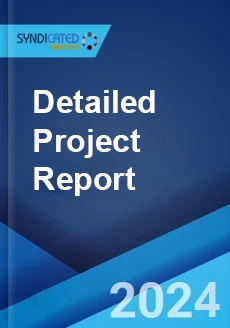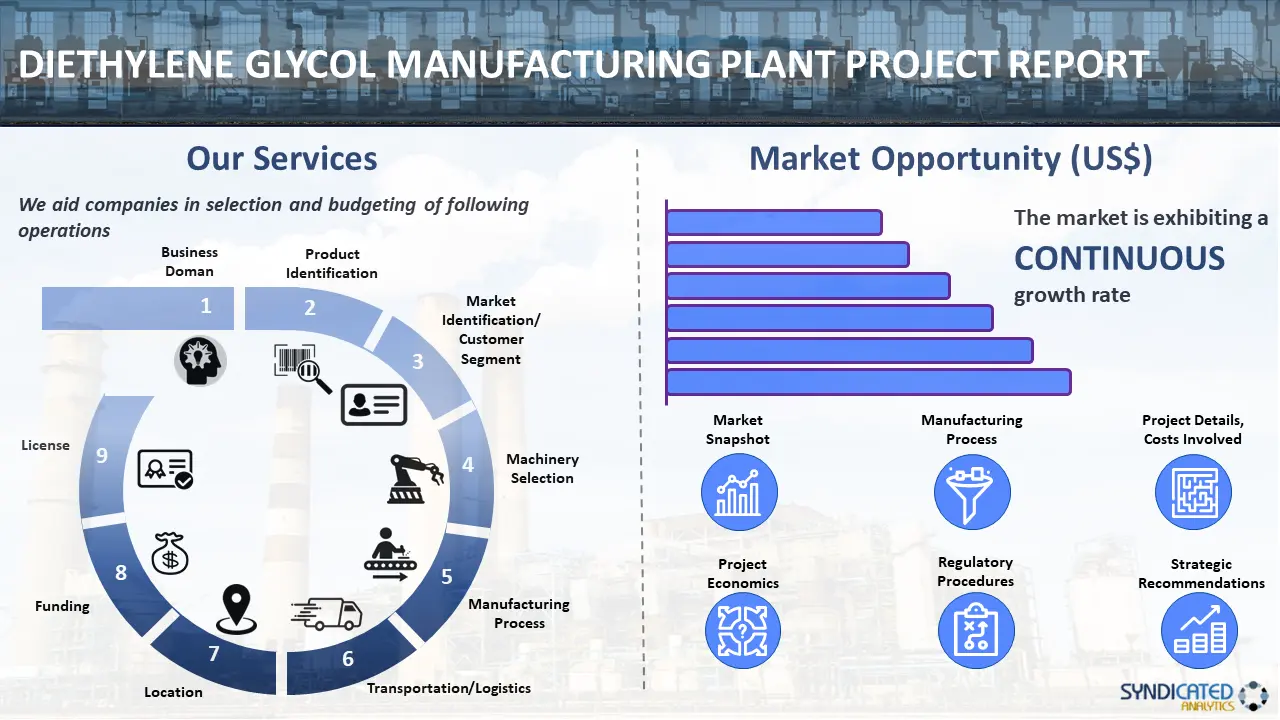
Diethylene Glycol Manufacturing Plant Project Report 2025 Edition
Report Coverage: Industry Analysis (Market Performance, Segments, Price Analysis, Outlook), Detailed Process Flow (Product Overview, Unit Operations, Raw Materials, Quality Assurance), Requirements and Cost (Machinery, Raw Materials, Packaging, Transportation, Utility, Human Resource), Project Economics (Capital Investments, Operating Costs, Profit Projections, Financial Analysis, Revenue), and Investment Opportunities
Report Overview:
The new report conducted by Syndicated Analytics, titled "Diethylene Glycol Manufacturing Plant Project Report 2025 Edition: Industry Analysis (Market Performance, Segments, Price Analysis, Outlook), Detailed Process Flow (Product Overview, Unit Operations, Raw Materials, Quality Assurance), Requirements and Cost (Machinery, Raw Materials, Packaging, Transportation, Utility, Human Resource), Project Economics (Capital Investments, Operating Costs, Profit Projections, Financial Analysis, Revenue), and Investment Opportunities," offers a comprehensive guide for establishing a manufacturing plant in the diethylene glycol industry. It encompasses a wide-ranging market overview and delves into specific details such as unit operations, raw material requirements, utility needs, infrastructure prerequisites, machinery and technology specifications, workforce demands, packaging prerequisites, transportation logistics, and more.
Furthermore, this report delivers extensive insights into project economics, including capital investments, project financing, operating costs, income and expenditure forecasts, fixed versus variable expenses, direct and indirect outlays, expected return on investment (ROI), net present value (NPV), profit and loss analysis, and comprehensive financial assessment.

Market Analysis
| Current Demand for Diethylene Glycol | The report evaluates the existing global demand for diethylene glycol. |
| Growth Prospects and Trends | The study delves into the growth prospects and emerging trends within the diethylene glycol market, providing insights to guide strategic decision-making. |
| Leading Segment and Regional Analysis | This study presents a concise overview of the key segments and regional influence in the diethylene glycol market, providing a comprehensive view of the industry's overall landscape. |
| Competitive Landscape | An analysis of the competitive landscape highlights key players in the diethylene glycol manufacturing industry, shedding light on their strategies and market positioning. |
Diethylene Glycol Market Overview:
The global diethylene glycol market is primarily driven because of its usage in building and construction sector mainly in materials essential for modern construction technologies. Diethylene glycol is used in construction materials such as paints, coatings and adhesives in order to enhance their application properties and durability. According to a report published by in Invest India, it is anticipated that around 600 million individuals will reside in urban areas by 2030, leading to a requirement for an extra 25 million affordable and mid-end housing units.
In addition to this, diethylene glycol is a key component in producing flexible plastics that are essential for consumer goods, electronics, and automotive industries. As these sectors require durable and adaptable materials, the demand for DEG is consistently increasing, making it an essential component in the production of flexible plastic solutions.
Diethylene Glycol Market Trends:
Rising Demand in Plastics and Polyester Production
Diethylene glycol is generally used as a plasticizer and is an important component in polyester production. According to an article published by CFDA, polyester is one of the most widely used fiber in the world. It accounts for roughly half of the overall fiber market and around 80% of synthetics fiber, according to the Textile Exchange Preferred Fiber Material Reports 2017. In the year 2016 polyester fiber production is estimated at 52,000,000 metric tons. As the demand for polyester fabric is on the rise the demand for diethylene glycol is also on the rise because of its indispensable role in creating polyester resins there by driving said diethylene glycol market growth.
Expansion in Automotive Industry
The automotive industry uses diethylene glycol in antifreeze and coolant formulations is one of the major factors driving the market growth. As the global automotive market grows mainly in emerging economies the need for diethylene glycol products is on the rise. According to an article published by European Automobiles Manufacturers Association, the global production of motor vehicles reached a total of 85.4 million in 2022, which represents a 5.7% increase over the previous year. Diethylene glycol role in automobile industry id to help in maintaining the engine temperatures and prevent engine freezing. As automotive sector grows so does the diethylene glycol market.
Latest Industry News:
- In April 2024, Huntsman introduced an innovative line of polyurethane foam technologies called SHOKLESS™ that are designed for the potting and fixation of cells in electric vehicle (EV) batteries.
- In 2024, India Glycols Ltd has recently increased the production capacity of its Kashipur bio-ethanol plant by 270 thousand liters per day (KLPD), bringing the total capacity of the plant to 410 KLPD. This expansion is in line with India's initiative to promote ethanol production and reduce dependency on non-renewable energy sources.
This report is essential reading for entrepreneurs, investors, researchers, consultants, and business strategists with interests in the diethylene glycol industry. It offers a thorough examination of the current state of the industry and its future potential, supplying valuable information for informed decision-making and strategic planning. Serving as an invaluable resource, this report provides a detailed exploration of the diethylene glycol industry, making it an indispensable tool for those looking to establish a strong presence in this dynamic sector.
Market Coverage:
| Current Demand for Diethylene Glycol | The report evaluates the existing global demand for diethylene glycol. |
| Growth Prospects and Trends | The study delves into the growth prospects and emerging trends within the diethylene glycol market, providing insights to guide strategic decision-making. |
| Leading Segment and Regional Analysis | This study presents a concise overview of the key segments and regional influence in the diethylene glycol market, providing a comprehensive view of the industry's overall landscape. |
| Competitive Landscape | An analysis of the competitive landscape highlights key players in the diethylene glycol manufacturing industry, shedding light on their strategies and market positioning. |
Project Feasibility
| Technical Feasibility | The study outlines the intricacies of diethylene glycol manufacturing, outlining the necessary equipment and technological requirements. A clear description of the manufacturing process is provided. |
| Financial Feasibility | The report presents an in-depth financial analysis, including the initial investment required, income and profit projections. These financial insights aim to assist potential investors in assessing the viability of the project. |
| Environmental and Regulatory Considerations | The report also discusses the environmental and regulatory aspects associated with diethylene glycol production, ensuring that the project aligns with sustainability and compliance standards. |
Project Implementation
| Location Selection | Choosing the optimal location for the manufacturing plant is crucial. This section explores location-based factors impacting the project's success. |
| Plant Design and Layout | Detailed plant design and layout plans are presented, emphasizing efficient production processes and workspace ergonomics. |
| Procurement of Raw Materials | An overview of the procurement process for raw materials necessary for diethylene glycol production is provided, ensuring a smooth supply chain. |
| Production Process | An explanation of the diethylene glycol production process is provided in the study, from raw material input to the final product, highlighting key stages and quality control measures. |
| Quality Control Measures | Stringent quality control measures are outlined to ensure the production of high-quality diethylene glycol. |
Risk Analysis
| Identification of Potential Risks | Potential risks associated with the project are identified, allowing for proactive risk management strategies. |
| Risk Mitigation Strategies | The report proposes risk mitigation strategies to minimize the impact of identified risks on the project's success. |
Seeking a Tailored Project Report?
While we have endeavored to create a comprehensive report, we acknowledge that each stakeholder may possess unique requirements. In light of this, we offer the option to customize the report to align with your specific needs. You can convey your business specifications to our consultants, and we will furnish you with a personalized scope tailored precisely to your requirements. Some of the common customizations that our clients often request include:
- Tailoring the report to suit the country/region where you intend to establish your plant.
- Adapting the manufacturing capacity of the plant to meet your specific needs.
- Customizing machinery suppliers and costs to align with your requirements.
- Incorporating any additional elements into the existing scope as per your specifications.
Report Scope:
| Features | Details |
|---|---|
| Currency | US$ (Information can also be provided in the local currency) |
| Pricing and Purchase Options | Single User License: US$ 3450 Five User License: US$ 4450 Corporate User License: US$ 5450 |
| Customization Scope | The report can also be customized based on the requirements of the customer. |
| Post-Sale Analyst Support | 12-14 Weeks |
| Delivery Format | PDF and Excel through email (We can also provide the editable version of the report in PPT/Word format on special request) |
Questions Addressed in the Report:
- What has been the performance of the diethylene glycol market to date, and what are the projections for its future growth?
- How is the diethylene glycol market segmented globally?
- How is the diethylene glycol market distributed across various regions?
- What trends are observed in the pricing of different feedstocks within the diethylene glycol industry?
- What constitutes the structure of the diethylene glycol industry, and who are its major stakeholders?
- What key operations are necessary for manufacturing diethylene glycol?
- How much land is required to establish a diethylene glycol manufacturing plant?
- What is the planned layout for a diethylene glycol manufacturing plant?
- What equipment is essential for starting a diethylene glycol manufacturing plant?
- What materials are needed to begin production in a diethylene glycol manufacturing plant?
- What are the packaging necessities for a diethylene glycol manufacturing plant?
- What transportation logistics are required for a diethylene glycol manufacturing plant?
- What utilities are needed to operate a diethylene glycol manufacturing plant?
- What staffing is necessary for the operation of a diethylene glycol manufacturing plant?
- What are the estimated infrastructure costs for establishing a diethylene glycol manufacturing plant?
- What initial investments are necessary for setting up a diethylene glycol manufacturing plant?
- What will the ongoing operational expenses be for a diethylene glycol manufacturing plant?
- How should be the pricing structure for the final product in the diethylene glycol industry?
- What are the expected revenues and costs associated with running a diethylene glycol manufacturing plant?
- How long will it take for the plant to reach the break-even point?
- What are the forecasted profits from establishing a diethylene glycol manufacturing plant?
- What factors determine success and what risks exist in the diethylene glycol industry?
- What regulations must be complied with to establish a diethylene glycol manufacturing plant?
- What certifications are necessary to operate a diethylene glycol manufacturing plant?
Why Choose Syndicated Analytics:
- Our reports offer valuable insights to stakeholders, enabling them to make informed business decisions confidently.
- We maintain a robust network of consultants and domain experts spanning over 100 countries across North America, Europe, Asia Pacific, South America, Africa, and the Middle East.
- Our extensive database includes equipment, and raw material suppliers from major continents, ensuring comprehensive coverage.
- We diligently track and update critical factors such as land costs, raw material costs, construction costs, utility expenses, labor costs, and more, across more than 100 countries worldwide.
- Syndicated Analytics is the trusted partner of choice for leading corporations, governments, and institutions globally. Our clientele ranges from small startups to Fortune 500 companies.
- Our dedicated in-house team comprises experts in various fields, including engineers, statisticians, modeling specialists, chartered accountants, architects, and more. They play a pivotal role in developing, expanding, and optimizing sustainable manufacturing facilities worldwide.
Purchase Options
Ask For Customization
Personalize this research
Triangulate with your own data
Get data as per your format and definition
Gain a deeper dive on a specific application, geography, customer or competitor
Any level of personalization
Get in Touch
Call us on
US: +1-213-316-7435
Uk: +44-20-8040-3201
Drop us an email at
sales@syndicatedanalytics.com